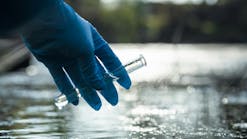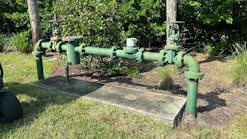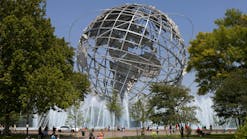Leachate Recirculation or Clean Water Addition: A Comparative Study
The solid waste community is beginning to understand the opportunity of leachate (moisture) recirculation for the stabilization of organic waste and the potential for reduction of long-term pollution from landfill seepage. The question becomes whether it is necessary to recirculate actual leachate or if it is more advantageous to add clean water for moisture control and thus derive benefit from the action of flushing the landfill cell.
The City of Fargo, ND, conducted a five-year, comparative parallel pilot study, applying actual leachate to one test cell and clean water in controlled amounts to the parallel test cell. The results strongly suggest that after an initial acclimation period, the rate of stabilization is not materially affected by the characteristics of the liquid applied. The benefit of controlling the amount of liquid applied, while being able to work with clean water, suggests that in the long term, clean water is safer and therefore the better liquid to apply.
The study in Fargo was initiated to investigate the feasibility of using specially constructed bioreactors to increase the rate of stabilization of MSW in a cold climate while simultaneously developing an operational technique similar to the city’s successful composting operation. One area of special interest in the project was observing the effects of cold weather on microbial activity.
Biological activity necessary for rapid stabilization was enhanced in this study by recirculating leachate produced in one test cell and by replacing all leachate generated with an equal amount of clean water in a similarly constructed, parallel test cell.
Leachate samples were collected and analyzed for several constituents over a period of about five years. After the initial warm-weather testing period, the observed results tended to indicate no appreciable difference in the leachate characteristics as a result of the type of liquid introduced.
Selected Review of Bioreactor Projects in the Literature
A brief review of the literature shows an increased interest in evaluating the landfill as a solid waste treatment system. Griffin (1998) states, “Solid Waste Management has always been driven by crisis. It is evident that the current practice of archiving solid waste for future generations is neither economically nor environmentally sound. It is clear that the future of managing solid waste must be based on the concepts of recycling and treatment.”
Pilot studies continue in the United States and abroad. Studies have been or are being conducted in Florida, Wisconsin, California, Georgia, Delaware, and many other locations. A full-scale test of aerobic digestion of MSW was conducted and reported by Hudgins and March (1998). They demonstrated that “an aerobically degrading MSW within a landfill can significantly increase the rate of waste decomposition and settlement, decrease the production of methane gas, reduce the level of toxic organics in the leachate, and decrease the quantities of leachate that need treatment.” Several South Carolina counties have requested that state’s consideration for use of an aerobic leachate recycling system.
The Delaware Solid Waste Authority (DSWA) is working to implement a state-of-the-art landfill expansion. The project will include, among other things, a leachate collection and storage system and a leachate recirculation and gas control system. The DSWA is convinced “when organic materials within a landfill are stabilized, they reduce the long-term risk of groundwater contamination, gas migration, and heavy metals” (CDM News, 1998).
As stated by Pacey (1999), “Perhaps the greatest potential benefit of the bioreactor landfill is its ability to reduce the very costly, 30-year-minimum, postclosure package mandated for the landfill’s care and maintenance. The goals and benefits associated with the bioreactor landfill are numerous and accrue socially, environmentally, and financially.”
A significant contribution to the area of landfill bioreactors is the 1997 publication Landfill Bioreactor Design and Operation by Debra R. Rheinhart and Timothy G. Townsend. This excellent work reviews experiences of numerous laboratory, pilot, and full-scale bioreactor tests and outlines important design parameters and operational procedures.
G. Fred Lee et al. (1994) published several excellent articles discussing not only the benefits but also the potential problems associated with landfill leachate recirculation. They state, “There is growing consensus that the dry tomb storage of MSW should be abandoned in favor of in-situ treatment of MSW so as to remove at the outset components that could otherwise eventually leak from the landfill to pollute groundwater.” They also suggest, “Leachate recycle must be followed by sufficient clean-water washing (leaching) of the fermented residues to remove the leachate components that represent long-term threats to public health and groundwater quality.”
When fully implemented, the processes of leachate recirculation and landfill mining may convert the landfill from a solid waste storage facility into a true solid waste management facility.
The objectives of the Fargo study were to:
- evaluate the feasibility of MSW stabilization in parallel landfill bioreactors,
- compare MSW stabilization rate and leachate characteristics from parallel reactors,
- observe the time required for significant reduction in leachate characteristics,
- observe the effects of cold weather,develop an operational process that could be applied to full-scale reactors.
Description of Bioreactors and Their Operation
The parallel bioreactors constructed for this study were approximately 12 x 12 ft. in area with a depth of about 10 ft. Each reactor had a PVC-lined bottom, a leachate collection system draining to a central sump, a leachate/water distribution network at the upper 2-ft. depth, and temperature-monitoring probes stacked at three depths within the active decomposition zone.
Generally once per week during the first years of the study, leachate was pumped out and recirculated to one reactor, while leachate in the parallel reactor was removed and an equal portion of clean water introduced. This routine was followed during the warmer months, generally April through November in North Dakota, while freezing was allowed during winter months.
The MSW used had been collected from typical residential neighborhoods and was hand placed and compacted, and all plastic bags were opened to ensure an even liquid application throughout the MSW.
Leachate samples were collected over approximately five years, with most samples analyzed during the early stages when significant differences in leachate characteristics were most apparent and changing dramatically. The volume of leachate and/or clean water applied and subsequently recovered was measured and analyzed for chemical oxygen demand (COD), pH, temperature, heavy metals, and several inorganic constituents.
After the initial wetting period, it appears that about 50% of the liquid was recovered. This is significant because other studies have reported that leachate recirculation may serve as a method of reducing the volume of leachate that might ultimately need to be treated off-site. This observation is important and requires further study.
COD and pH sampling extended over the entire project life. The most significant COD reduction and pH increase, however, were seen during the initial testing phase. After the first summer of activity and the first winter period of freezing, the COD values were approximately the same regardless of the liquid injected.
The south bioreactor, in which leachate was recirculated, initially produced a higher concentration of COD, after which the CODs measured were essentially the same as those found in the parallel north bioreactor. COD data with respect to time was fit to a pseudo-first-order relationship.
The equations thus developed for each bioreactor are as follows:
North bioreactor with clean-water addition:
CODt = 8819e-00148t R2 = 0.838
South bioreactor with actual leachate recirculation:
CODt = 13638e-00178t R2= 0.899
The equations suggest that, after a period of approximately two years, leachate characteristics as represented by COD measurements were essentially the same. This does not represent a total reduction in COD, however, but would indicate a less-contaminated leachate if seepage is a result of liner failure.
The temperature variation over time within the reactors clearly reflects the effects of cold weather in Fargo. In the spring, the MSW and its leachate were found to be quite cold, and as the weather warmed, the bioactivity increased. It is assumed that critical masses larger than the test cells would better hold the heat generated by microbial activity and thus remain more active during the winter season. Fargo has realized temperatures of 150ºF in its yardwaste composting operation during cold weather, utilizing specially constructed windrows, and therefore is confident that an MSW bioreactor (digester/composter) can work effectively underground in extreme conditions.
Specific conductance and total dissolved solids were measured during the initial testing phase. It was observed during the first year that both the specific conductance and total dissolved solids were lower in the leachate of the bioreactor that was essentially being flushed with clean water. As in the COD analysis, it is anticipated that, after the initial phase of testing, all constituents would depend more upon the makeup of the material undergoing stabilization than the liquid applied.
The City of Fargo has operated a very successful yardwaste composting operation for several years and has further studied composting agricultural waste from sugar beet tailings and sewage sludge. A correlation can be drawn between the composting success achieved and the potential success of bioreactors for breakdown and stabilization of MSW. At the present time, the city is conducting soil (landfill) borings to establish the best locations for nested injection wells in a closed landfill cell about 4 ac. in area and 75 ft. in depth. A clean-water injection system of gravel trenches and nested wells is under design and will be installed in the spring of 2000, with water injection planned for early summer. It is further anticipated that this project will incorporate the addition of air injection such that the cell will be stabilized as an aerobic reactor.
An older landfill cell completed in the 1960s is also under evaluation for clean-water recirculation, air injection, organic stabilization, landfill mining, and an upgrade to satisfy the latest government standards.
There is a significant need for this type of research to continue, as there remains uncertainty in regard to large landfill stabilization. But the time has come to ask the question again: Do we want to continue to entomb solid waste for future generations or should we use the best method of waste treatment to solve an obvious problem? We have the knowledge and understand the process; we need to convince others of the longer-term environmental benefits of developing engineered solid waste treatment systems.





